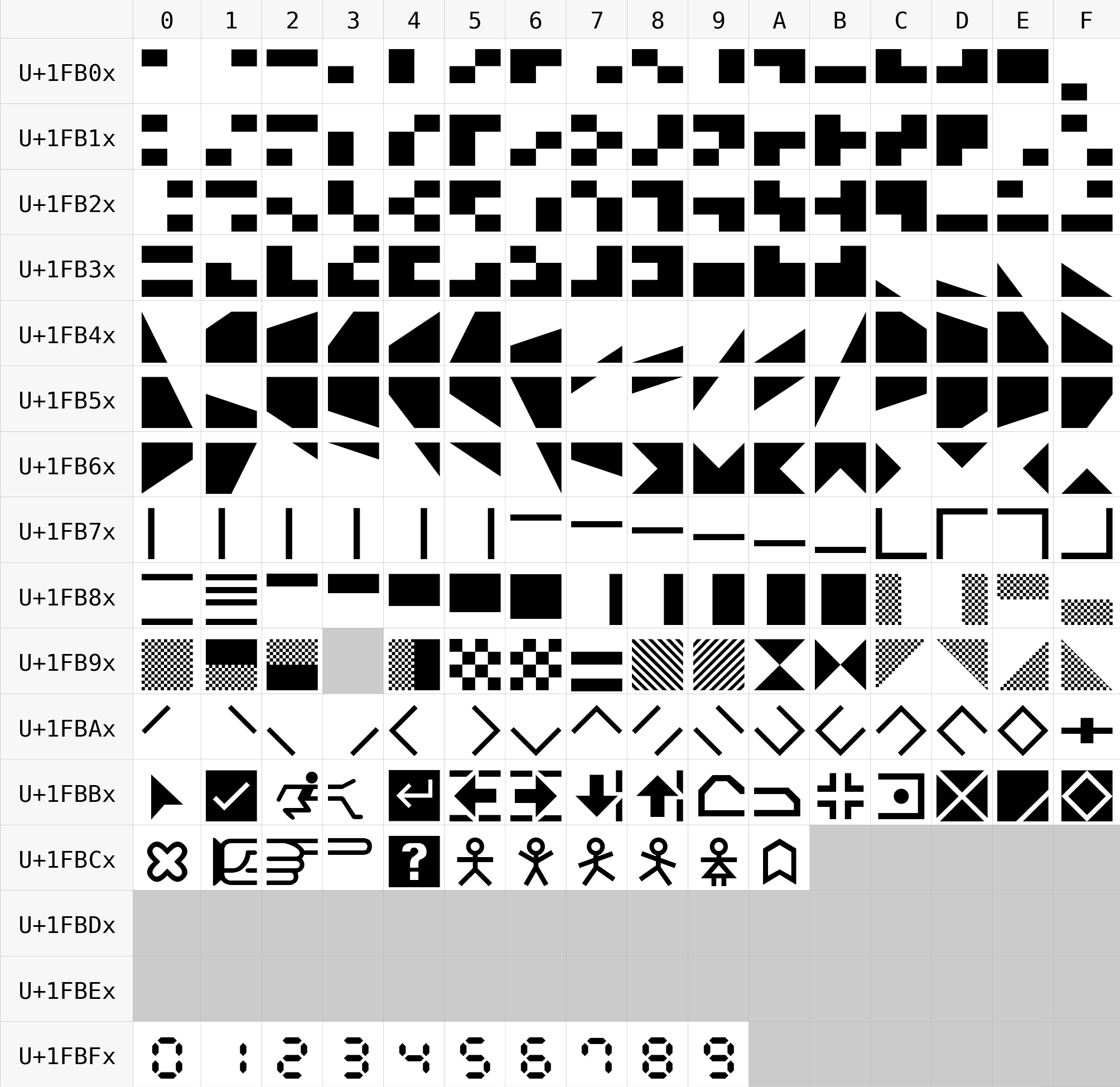Symbols For Legacy Computing on:
[Wikipedia]
[Google]
[Amazon]
Symbols for Legacy Computing is a

Cascadia Code 2404.23
– release notes for Cascadia Code, which shows the rendering of Symbols for Legacy Computing Supplement characters Unicode blocks
Unicode block
A Unicode block is one of several contiguous ranges of numeric character codes (code points) of the Unicode character set that are defined by the Unicode Consortium for administrative and documentation purposes. Typically, proposals such as the ...
containing graphic characters that were used for various home computer
Home computers were a class of microcomputers that entered the market in 1977 and became common during the 1980s. They were marketed to consumers as affordable and accessible computers that, for the first time, were intended for the use of a s ...
s from the 1970s and 1980s and in teletext
Teletext, or broadcast teletext, is a standard for displaying text and rudimentary graphics on suitably equipped television sets. Teletext sends data in the broadcast signal, hidden in the invisible vertical blanking interval area at the to ...
broadcasting standards. It includes characters from the Amstrad CPC
The Amstrad CPC (short for "Colour Personal Computer") is a series of 8-bit home computers produced by Amstrad between 1984 and 1990. It was designed to compete in the mid-1980s home computer market dominated by the Commodore 64 and the ZX Spec ...
, MSX
MSX is a standardized home computer architecture, announced by ASCII Corporation on June 16, 1983. It was initially conceived by Microsoft as a product for the Eastern sector, and jointly marketed by Kazuhiko Nishi, the director at ASCII Corpo ...
, Mattel Aquarius, RISC OS
RISC OS () is an operating system designed to run on ARM architecture, ARM computers. Originally designed in 1987 by Acorn Computers of England, it was made for use in its new line of ARM-based Acorn Archimedes, Archimedes personal computers an ...
, MouseText
MouseText is a set of 32 graphical characters designed by Bruce Tognazzini and first implemented in the Apple IIc. They were then retrofitted to the Apple IIe forming part of the Enhanced IIe upgrade. A slightly revised version was then released w ...
, Atari ST
Atari ST is a line of personal computers from Atari Corporation and the successor to the company's Atari 8-bit computers, 8-bit computers. The initial model, the Atari 520ST, had limited release in April–June 1985, and was widely available i ...
, TRS-80 Color Computer
The RadioShack TRS-80 Color Computer, later marketed as the Tandy Color Computer, is a series of home computers developed and sold by Tandy Corporation. Despite sharing a name with the earlier TRS-80, the Color Computer is a completely different ...
, Oric, Texas Instruments TI-99/4A, TRS-80
The TRS-80 Micro Computer System (TRS-80, later renamed the Model I to distinguish it from successors) is a desktop microcomputer developed by American company Tandy Corporation and sold through their Radio Shack stores. Launched in 1977, it is ...
, Minitel, Teletext
Teletext, or broadcast teletext, is a standard for displaying text and rudimentary graphics on suitably equipped television sets. Teletext sends data in the broadcast signal, hidden in the invisible vertical blanking interval area at the to ...
, ATASCII, PETSCII, ZX80
The Sinclair ZX80 is a home computer launched on 29 January 1980 by Science of Cambridge Ltd. (later to be better known as Sinclair Research). It is notable for being one of the first computers available in the United Kingdom for less than a hu ...
, and ZX81
The ZX81 is a home computer that was produced by Sinclair Research and manufactured in Dundee, Scotland, by Timex Corporation. It was launched in the United Kingdom in March 1981 as the successor to Sinclair's ZX80 and designed to be a low-c ...
character sets. Semigraphics characters are also included in the form of new block-shaped characters, line-drawing characters, and 60 "sextant" characters (semigraphic character made up of six smaller blocks). Additional characters were added to this block in Unicode 16.0 as well.
A supplemental block ( Symbols for Legacy Computing Supplement) was added with Unicode 16.0.
Block
The image below is provided as quick reference for these symbols on systems that are unable to display them directly (although it lacks code points newly assigned in Unicode 16.0):
History
The following Unicode-related documents record the purpose and process of defining specific characters in the Symbols for Legacy Computing block:See also
*Box-drawing characters
Box-drawing characters, also known as line-drawing characters, are a form of semigraphics widely used in text user interfaces to draw various geometric frames and boxes. These characters are characterized by being designed to be connected horiz ...
* Dingbat
In typography, a dingbat (sometimes more formally known as a printer's ornament or printer's character) is an ornament, specifically, a glyph used in typesetting, often employed to create box frames (similar to box-drawing characters), or a ...
* other Unicode blocks
** Box Drawing
** Block Elements
** Geometric Shapes
A shape is a graphics, graphical representation of an object's form or its external boundary, outline, or external Surface (mathematics), surface. It is distinct from other object properties, such as color, Surface texture, texture, or material ...
** Halfwidth and Fullwidth Forms
In CJK characters, CJK (Chinese, Japanese, and Korean) computing, graphic characters are traditionally classed into fullwidth and halfwidth characters. Unlike monospaced fonts, a halfwidth character occupies half the width of a fullwidth characte ...
** Supplemental Arrows-C
Supplemental Arrows-C is a Unicode block
A Unicode block is one of several contiguous ranges of numeric character codes (code points) of the Unicode character set that are defined by the Unicode Consortium for administrative and documentation ...
** Symbols for Legacy Computing Supplement
References
{{reflistExternal links
Cascadia Code 2404.23
– release notes for Cascadia Code, which shows the rendering of Symbols for Legacy Computing Supplement characters Unicode blocks